Last Updated on March 18, 2025
By now you’ve probably seen the cruelty-free label on some of your products. But what exactly does it mean? And how does it correlate to sustainability?
Many beauty items are labeled cruelty-free, such as cosmetics and skincare. But many other items can carry the label, such as shoes, clothing, accessories and cleaning supplies.
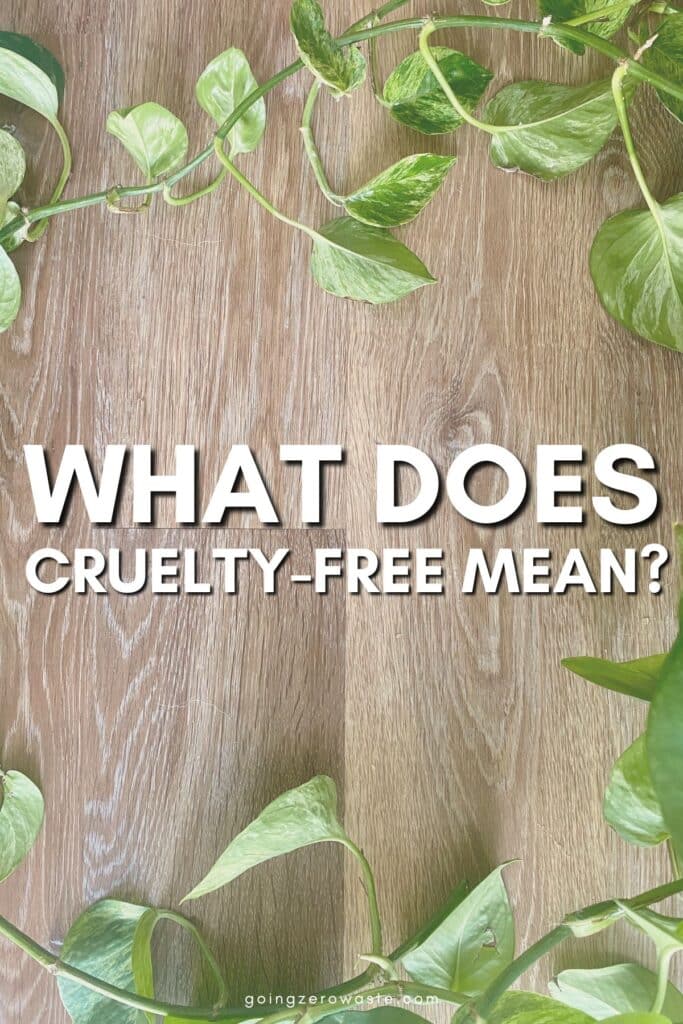
The cruelty-free label essentially means no animals were harmed in the making of said product, or ingredient. This is important for a multitude of reasons, one being the inhumane treatment of lab animals. Most animals in laboratories are not legally protected and are subjected to horrifically painful experiments, often without pain killers.
Additionally, animals used for lab testing contribute to pollution and biodiversity loss. Animals, the most common being monkeys, are often taken from their natural habitats and bred in captivity for lab usage. Alongside this, millions of animal bodies and bedding are disposed of each year, creating biological hazardous waste.
Unfortunately, up to 126.9 million non-human vertebrate animals on a global scale are bred, used, and disposed for animal testing. This leads to a slew of ethical and environmental concerns.
This is why it’s vital to look for brands that don’t test on animals whenever possible. There are several ways we can do this, like choosing to go vegan or plant-based, advocating for animal rights, and checking for cruelty-free certified products.
Here’s what you need to know about animal testing and why opting for brands that avoid this matters.
is cruelty-free same as vegan?
No, cruelty-free is not the same as vegan. Cruelty-free means the product was developed without any tests on animals, whereas vegan means the product does not include any animal-derived ingredients.
Ideally, a product will be both vegan and cruelty-free. However, just because it is vegan does not automatically make it cruelty-free, and vice versa.
So, for example, a plant-based lipstick derived from vegan ingredients can still be considered “not cruelty-free” if it was tested on animals.
RELATED: The Best Vegan Shoes: 8 Brands Making Cruelty-Free Footwear

what is the legal definition of cruelty-free?
There is no legal definition of cruelty-free. The term can be used by any brand – so keep that in mind while shopping around for products. However, to ensure legitimacy, it’s best to look for certifications, like Leaping Bunny Certification. This ensures third party testing was involved.
In order to get Leaping Bunny certified, brands must:
- Adhere to a fixed cut-off date, an unalterable date after which neither the brand nor any of its suppliers and/or manufacturers may conduct, commission or be party to animal tests.
- Set up a Supplier Monitoring System to ensure all their suppliers and manufacturers comply with Leaping Bunny criteria.
- Be open to independent audits to ensure their Supplier Monitoring System adheres to the Leaping Bunny Standard.
- Renew their commitment to the Leaping Bunny Program annually.

is cruelty-free a good thing?
Yes, cruelty-free is a good thing, because it prevents unnecessary suffering and promotes more ethical testing of products.
In terms of its environmental impact, animal testing is resource-intensive, requiring substantial amounts of water, food, and shelter for the animals. The facilities housing lab animals consume energy up to ten times more than offices on a square meter basis.
There’s also the issue of chemical waste. A wide range of chemicals are used throughout animal testing for sanitation, disinfection, and sterilization. Toxic substances like irritants, neurotoxins and carcinogens are frequently used for extended periods of time in large amounts. These toxins can contaminate soil and water if not disposed of correctly.
When animal bodies are eventually discarded after use, they are often incinerated on-site, which contributes to air pollution. Incineration is extremely harmful to human health, causing chronic illness and developmental delays in nearby populations. Between 11 to 44 percent of U.S. laboratory workers experience allergic reactions to laboratory animals. Between 4 to 22 percent suffer from occupational asthma.
By supporting cruelty-free brands, you are ensuring no animal was harmed for the sake of your product. You’re also helping more ethical, humane, and sustainable alternatives become the norm.
what are cruelty-free products?
Cruelty-free products are any product that isn’t tested on animals in each and every phase of the production.
I’ve compiled a list of brands that don’t test on animals. I’ve gone ahead and highlighted some key features of each brand, but it isn’t an exhaustive list. Be sure to check out their websites for more information.
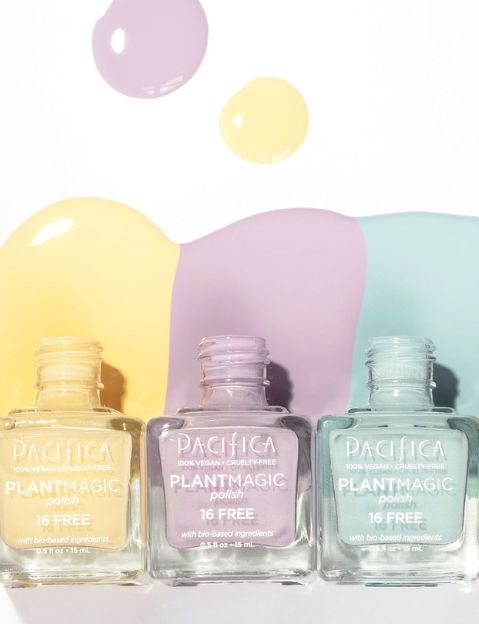
1. pacifica
- Natural skincare, haircare + cosmetics
- Bio sourced ingredients
- Vegan and cruelty-free
- Partner with the ACLU and the Gentle Barn
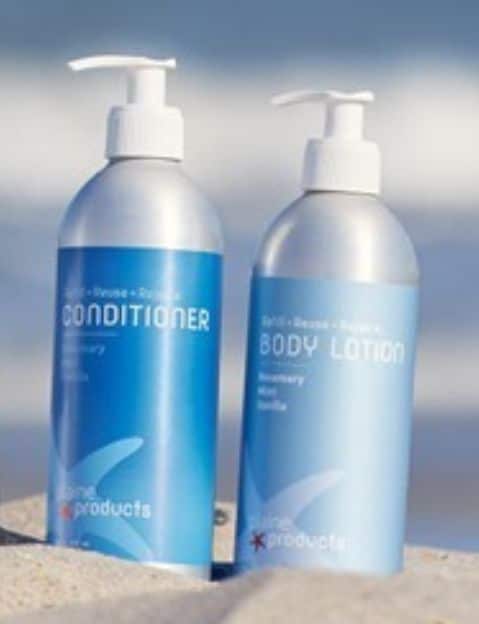
2. plaine products
- Natural, plant-based haircare and skincare
- Rosemary mint vanilla, citrus lavender, and unscented options
- Refillable + comes plastic-free aluminum bottles
- Vegan, cruelty-free, women owned, carbon neutral
- 100% plastic-free shipping

3. ecoroots
- All-natural skincare and haircare products
- Various scents available
- Vegan + cruelty-free
- Silicone Free, Phthalate-free & Paraben Free
- Plastic-free shipping

4. brixy
- Natural shampoo, conditioner + body wash bars
- 3 scents available: citrus, mint eucalyptus and coconut vanilla
- Vegan + cruelty-free
- Free from palm oil, sulfates, silicones, phthalates, parabens, synthetic scents + colorants

5. ethique
- Natural body + haircare products
- Various scents + types available
- Vegan + cruelty-free
- Plastic free + home compostable packaging

6. good time
- Natural hair + body bars
- No parabens, sulphates, or preservatives
- Vegan + cruelty-free
- Carbon neutral shipping
- 50% of profits to clean water initiatives

7. patch
- Compostable bamboo bandages
- Come packaged in recycled cardboard
- Organic content
- Vegan + cruelty-free
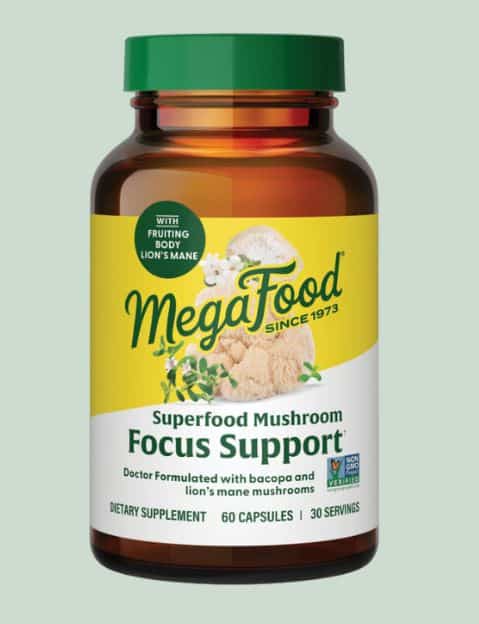
8. megafood
- Sustainable vitamins and supplements
- USDA Certified Organic
- Committed to regenerative agriculture
- Fair employment practices
- Lobbying to ban glyphosate
- Vegan, gluten-free + cruelty-free
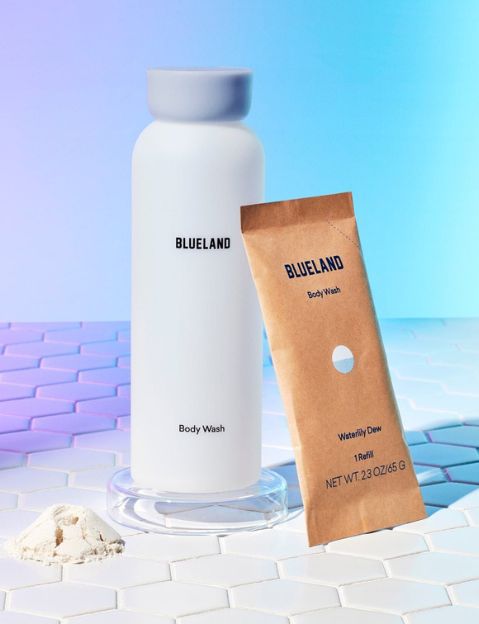
9. blueland
- Sustainable cleaning + personal care products
- Refillable + compostable refill packets
- Hypoallergenic
- Leaping bunny certified
- B corp

10. nae shoes
- Women, men + unisex footwear
- Vegan + cruelty-free
- Made from sustainable materials like Pinatex, apple skin, cork, organic cotton, etc.
- Pre-loved program allows you to send back your shoes to be recycled or resold
So, which of these sustainable brands free of animal testing would you like to try? Let me know in the comments!
The post What Does Cruelty-Free Mean? +10 Ethical Brands appeared first on Going Zero Waste.
Green Living
The Many Layers of Personal Style
Personal style is a dance between dualities: fashion as art and fashion as function; clothing as self-expression and clothing for our circumstances.
Style is a medium for communication and self-expression, yes. But it’s also shaped by the environments and requirements around us, from workplace dress codes to city cultures, climates, and specific occassions.
In last Saturday’s workshop, where we talked about how to remix what you already have in your closet, attendees shared a common challenge:
How do you balance your personal style expression while dressing for the various situations and environments we operate in?
“I’ve found above all else my style is highly influenced by my environment (my job, my city etc.)—sometimes it becomes about ‘fitting in’ and losing individuality”
“I find I’m too led by my day-to-day lifestyle. I WFH and so often I just don’t get dressed at all.”
“There are too many applications: workout, work, at home, formal occasion.”
Style as Identity vs. Style as Communication
It’s no wonder style and getting dressed can feel so confusing.
In the personal style world, we learn to dress for who we are on the inside. And then we see the style rules in fashion media: here’s how to dress for this season, this dress code, this city.
And in our real lives, we have real dress codes we might have to follow, whether for a workplace or a wedding.
But what if all those sides conflict?
- If my style words are “casual” or “sporty” but I’m in a workplace 40+ hours a week that requires business formal, where does that leave my personal style?
- If I love vibrant and artsy looks, but I live in a city full of neutrals, what do I wear?
It’s no surprise it feels… complicated.
Here’s my take.
We’re Not One-Dimensional — Neither is Our Style
Sometimes I want to disconnect and live in cottage in the mountains, surrounded by more trees than people. Other days I dream of having an apartment in the center of Paris where I see more people in a day than live in my hometown.
I’m light, joyful, maybe even quirky with friends. I’m ambitious, intentional, perhaps more serious in work. There are times I feel it’s best to soften and let it go; other times it feels most aligned to be unapologetically outspoken.
We are human. We’re social creatures. We’re complex and full of contradictions.
Social media has trained us to fit people into neat boxes because “niche” is what performs in the algorithm.
In real life, though, our “authentic” selves aren’t so one-dimensional.
I’m not speaking to new networking contacts the same exact way I talk to my best friend I’ve known for years. That doesn’t mean I’m pretending to be someone else. It just means I’m showing up a bit differently depending on the context.
Similarly, our personal style doesn’t have to be expressed in one singular way.
That’s what’s beautiful about fashion! We have the opportunity to express ourselves a bit differently each and every time we get dressed.
What we wear might ebb and flow with a situation, the season, or our mood. There are common threads, but differentiators too.
Three distinctly different looks can all be authentic.
For me, personal style isn’t about being setting such rigid parameters that we can no longer embrace our multi-dimensional nature.
And there’s undoubtedly the layers of privilege at work here too. Is it safe to dress in alignment with your true identity in that particular situation? Will you be taken seriously? Could there be repercussions?
There’s a lot to untangle when it comes to what we wear.
Making Our Multi-Dimensional Style Practical
As I shared in last week’s workshops, style is many layers. The four I see it through are the vibe, the shapes, the colors & textures, and our lifestyle & values.

The aesthetic reflects your vibe, mood or style adjectives.
- For example, my vibe or adjectives are feminine, structured, grounded.
The shapes are the fits, silhouettes, and proportions you love.
- I often wear outfits with a straight silhouette or tailored fit balanced with a relaxed, flowy, or drapey element.
Colors & textures include your preferred palettes, fabrics, and the way materials feel.
- I prefer wearing natural fibers when possible. I like gold jewelry, and I feel more aligned in lower contrast looks. Lighter colors for day. Sometimes darker for evening or certain events.
The lifestyle & values element is the consideration of your actual day-to-day. What situations and environments are you dressing for? What is important to you?
- I work from home so comfort is key most of the time. I value slow fashion practices — rewearing, repairing, and supporting circular practices and sustainably-minded brands.
Once you understand these layers of your style, the next step is figuring out how to apply them in real-life situations.
Applying Your Style to the Situation
In last week’s workshops, I talked about the role of outfit templates here for various situations. What is the foundational blueprint of what you might wear to your office, working from home, in a school setting, at home, running errands, and so on?
There are opportunities to bring in the layers of your personal style in these various situations, but it does require some intentionally on the outset. Otherwise, it’s easy to fall into our old patterns or copy what others around us wear. (Even subconsciously, as fashion psychologist Shakaila Forbes-Bell has shared!)

Here’s one of my work-from-home outfit templates that balances style and situational needs:
- Blouse with feminine detail: I start with the top for Zoom calls!
- Straight-leg bottoms: this could be jeans, colorful pants, or a column skirt
- Slim shoes: the general “slim” descriptor makes it versatile across seasons
- Structured bag: an option to add polish when coworking at a café
By thinking in these various layers (vibe, shapes, colors & textures, and lifestyle & values) you can build outfits that feel authentic to you while fitting the constraints of the external situation.
What About One-Off Unique Situations?
Like this Wednesday evening, I spoke on a “Sustainable Fashion in Action” panel with Chicago Climate Connect during Sustainable Fashion Week Chicago. But the panel was also taking place at the Patagonia x Worn Wear store.
So the vibe was professional meets fashion, but also kinda casual?! And we are still in the Midwest here. I have to say, this one wasn’t easy.
But here’s the step-by-step thought process that helped me balance my style, function, and a unique-to-me context.

- I picked a foundational piece: My navy wide-leg trousers were business casual without being too formal and were practical for train travel.
- And functional accessories:My old Coach bag fits everything and my chunky Veja sneakers matched the vibe I was going for so those were the picks.
- Then a piece that brought it all together:At this point I was mixing high-contrast colors (white with navy & black) and different vibes (trousers vs. sneakers). I felt like I needed a bridge for the outfit, and this navy-striped vest tied it all together.
- Finally, some final touches: Gold jewelry made the look feel more “me”, while this cap from Abbie at The Filtery made it all feel effortless.
In the end, this outfit took a lot longer to create than a typical look.
It took longer to create than my usual outfits, but it felt just right. The combination was practical, suited my style, fit the vibe of the panel, and aligned with the weather.
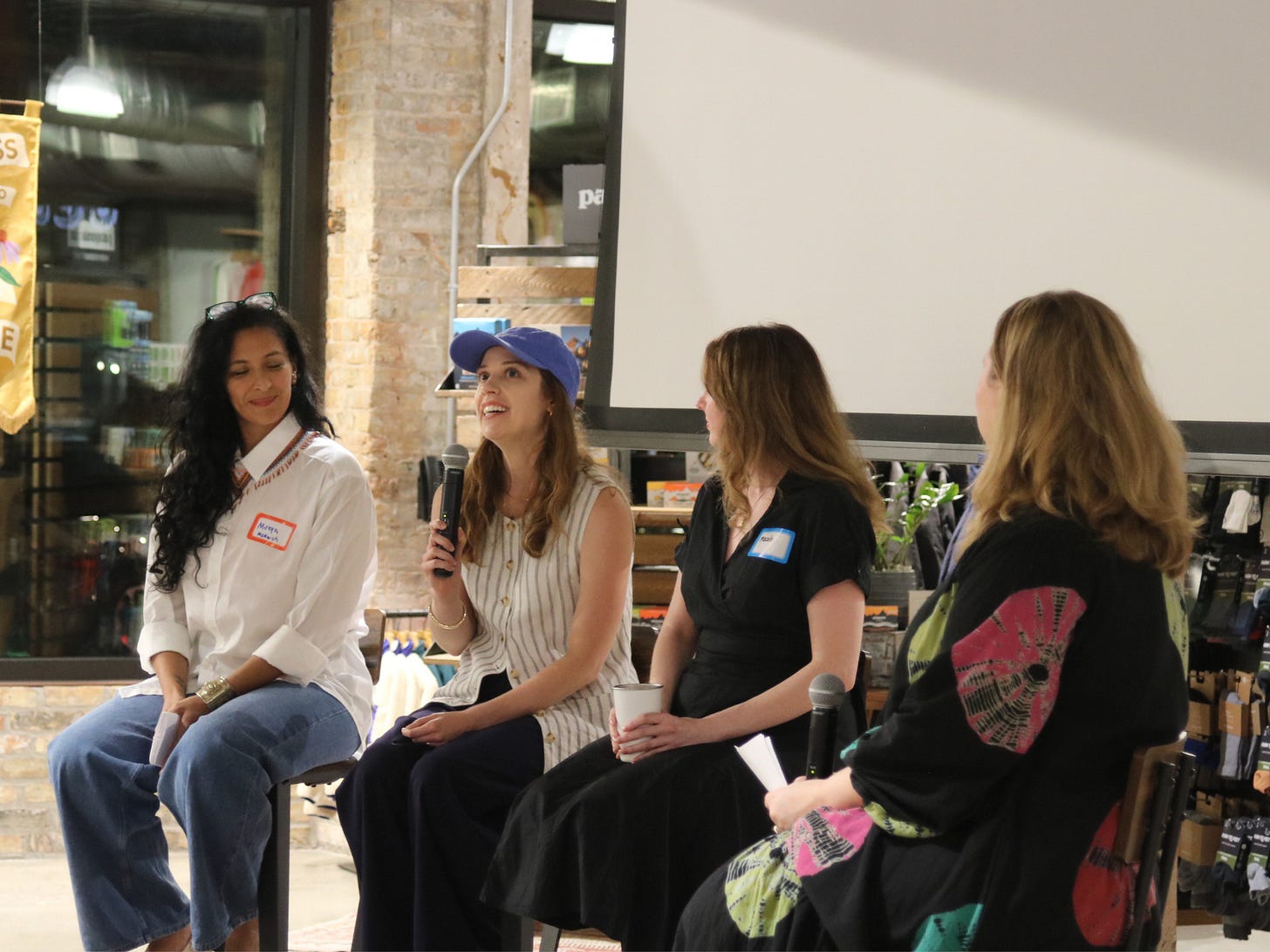
This panel outfit reminded me that style is what we wear to express ourselves, but it’s also a tool to help us navigate our lives. By thinking through these layers of personal style (vibe, shapes, colors, textures, and lifestyle needs) we can balance showing up authentically while honoring the nuances or navigating the constraints of a situation.
For me, that’s the real power of personal style.
One single outfit can’t tell the whole story of who we are. But personal style can be flexible, functional, and expressive of the many sides of our multi-dimensional nature.
So lately, more than asking “does this outfit perfectly express my full self?” I’ve been finding myself asking:
“Does this outfit help me show up in the way I want to? Does it say what I want it to say in this particular moment?“
The post The Many Layers of Personal Style appeared first on .
Green Living
You’re multi-dimensional. So is your style.
Personal style is a dance between dualities: fashion as art and fashion as function; clothing as self-expression and clothing for our circumstances.
Style is a medium for communication and self-expression, yes. But it’s also shaped by the environments and requirements around us, from workplace dress codes to city cultures, climates, and specific occassions.
In last Saturday’s workshop, where we talked about how to remix what you already have in your closet, attendees shared a common challenge:
How do you balance your personal style expression while dressing for the various situations and environments we operate in?
“I’ve found above all else my style is highly influenced by my environment (my job, my city etc.)—sometimes it becomes about ‘fitting in’ and losing individuality”
“I find I’m too led by my day-to-day lifestyle. I WFH and so often I just don’t get dressed at all.”
“There are too many applications: workout, work, at home, formal occasion.”
Style as Identity vs. Style as Communication
It’s no wonder style and getting dressed can feel so confusing.
In the personal style world, we learn to dress for who we are on the inside. And then we see the style rules in fashion media: here’s how to dress for this season, this dress code, this city.
And in our real lives, we have real dress codes we might have to follow, whether for a workplace or a wedding.
But what if all those sides conflict?
- If my style words are “casual” or “sporty” but I’m in a workplace 40+ hours a week that requires business formal, where does that leave my personal style?
- If I love vibrant and artsy looks, but I live in a city full of neutrals, what do I wear?
It’s no surprise it feels… complicated.
Here’s my take.
We’re Not One-Dimensional — Neither is Our Style
Sometimes I want to disconnect and live in cottage in the mountains, surrounded by more trees than people. Other days I dream of having an apartment in the center of Paris where I see more people in a day than live in my hometown.
I’m light, joyful, maybe even quirky with friends. I’m ambitious, intentional, perhaps more serious in work. There are times I feel it’s best to soften and let it go; other times it feels most aligned to be unapologetically outspoken.
We are human. We’re social creatures. We’re complex and full of contradictions.
Social media has trained us to fit people into neat boxes because “niche” is what performs in the algorithm.
In real life, though, our “authentic” selves aren’t so one-dimensional.
I’m not speaking to new networking contacts the same exact way I talk to my best friend I’ve known for years. That doesn’t mean I’m pretending to be someone else. It just means I’m showing up a bit differently depending on the context.
Similarly, our personal style doesn’t have to be expressed in one singular way.
That’s what’s beautiful about fashion! We have the opportunity to express ourselves a bit differently each and every time we get dressed.
What we wear might ebb and flow with a situation, the season, or our mood. There are common threads, but differentiators too.
Three distinctly different looks can all be authentic.
For me, personal style isn’t about being setting such rigid parameters that we can no longer embrace our multi-dimensional nature.
And there’s undoubtedly the layers of privilege at work here too. Is it safe to dress in alignment with your true identity in that particular situation? Will you be taken seriously? Could there be repercussions?
There’s a lot to untangle when it comes to what we wear.
Making Our Multi-Dimensional Style Practical
As I shared in last week’s workshops, style is many layers. The four I see it through are the vibe, the shapes, the colors & textures, and our lifestyle & values.

The aesthetic reflects your vibe, mood or style adjectives.
- For example, my vibe or adjectives are feminine, structured, grounded.
The shapes are the fits, silhouettes, and proportions you love.
- I often wear outfits with a straight silhouette or tailored fit balanced with a relaxed, flowy, or drapey element.
Colors & textures include your preferred palettes, fabrics, and the way materials feel.
- I prefer wearing natural fibers when possible. I like gold jewelry, and I feel more aligned in lower contrast looks. Lighter colors for day. Sometimes darker for evening or certain events.
The lifestyle & values element is the consideration of your actual day-to-day. What situations and environments are you dressing for? What is important to you?
- I work from home so comfort is key most of the time. I value slow fashion practices — rewearing, repairing, and supporting circular practices and sustainably-minded brands.
Once you understand these layers of your style, the next step is figuring out how to apply them in real-life situations.
Applying Your Style to the Situation
In last week’s workshops, I talked about the role of outfit templates here for various situations. What is the foundational blueprint of what you might wear to your office, working from home, in a school setting, at home, running errands, and so on?
There are opportunities to bring in the layers of your personal style in these various situations, but it does require some intentionally on the outset. Otherwise, it’s easy to fall into our old patterns or copy what others around us wear. (Even subconsciously, as fashion psychologist Shakaila Forbes-Bell has shared!)
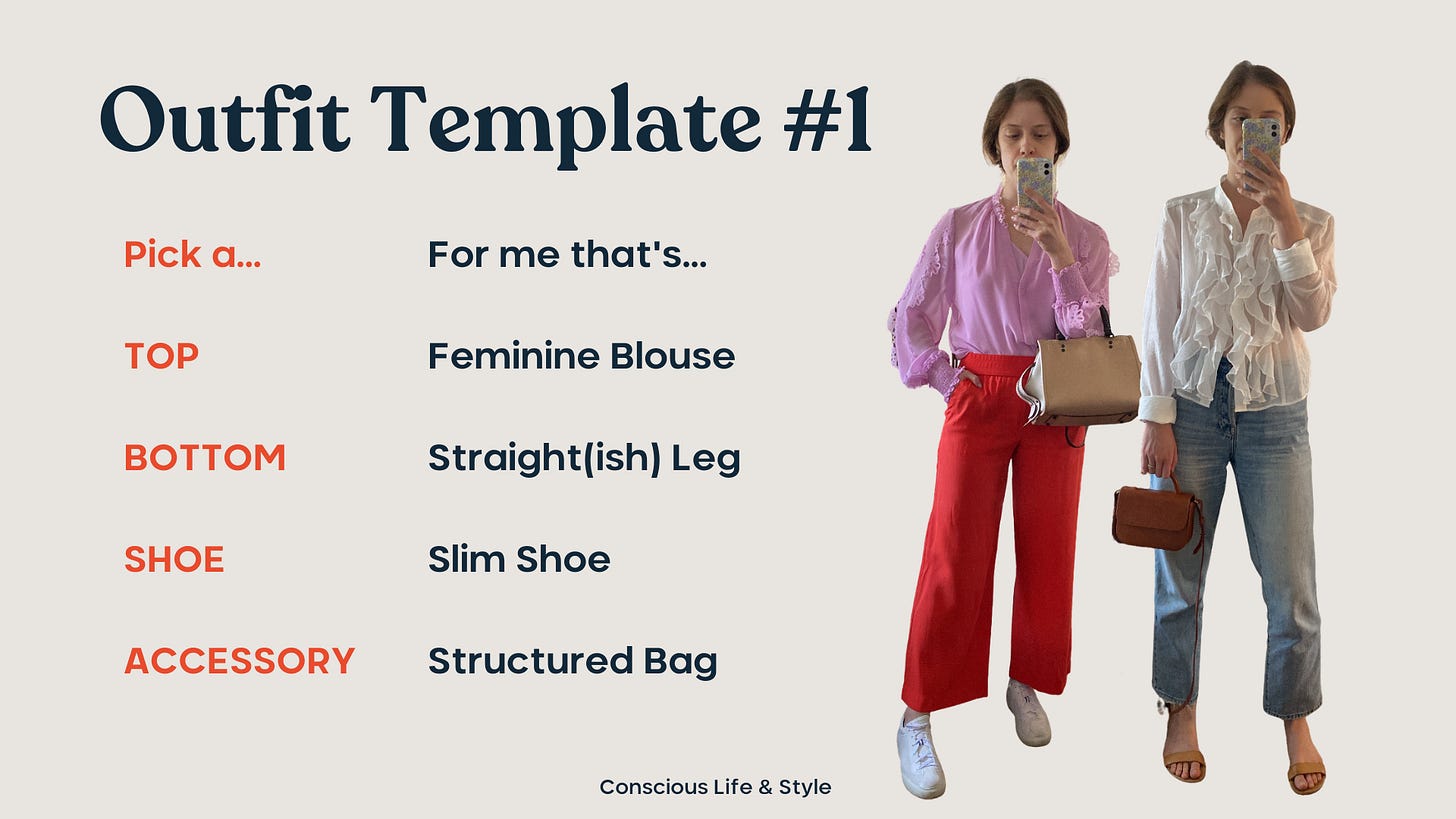
Here’s one of my work-from-home outfit templates that balances style and situational needs:
- Blouse with feminine detail: I start with the top for Zoom calls!
- Straight-leg bottoms: this could be jeans, colorful pants, or a column skirt
- Slim shoes: the general “slim” descriptor makes it versatile across seasons
- Structured bag: an option to add polish when coworking at a café
By thinking in these various layers (vibe, shapes, colors & textures, and lifestyle & values) you can build outfits that feel authentic to you while fitting the constraints of the external situation.
What About One-Off Unique Situations?
Like this Wednesday evening, I spoke on a “Sustainable Fashion in Action” panel with Chicago Climate Connect during Sustainable Fashion Week Chicago. But the panel was also taking place at the Patagonia x Worn Wear store.
So the vibe was professional meets fashion, but also kinda casual?! And we are still in the Midwest here. I have to say, this one wasn’t easy.
But here’s the step-by-step thought process that helped me balance my style, function, and a unique-to-me context.
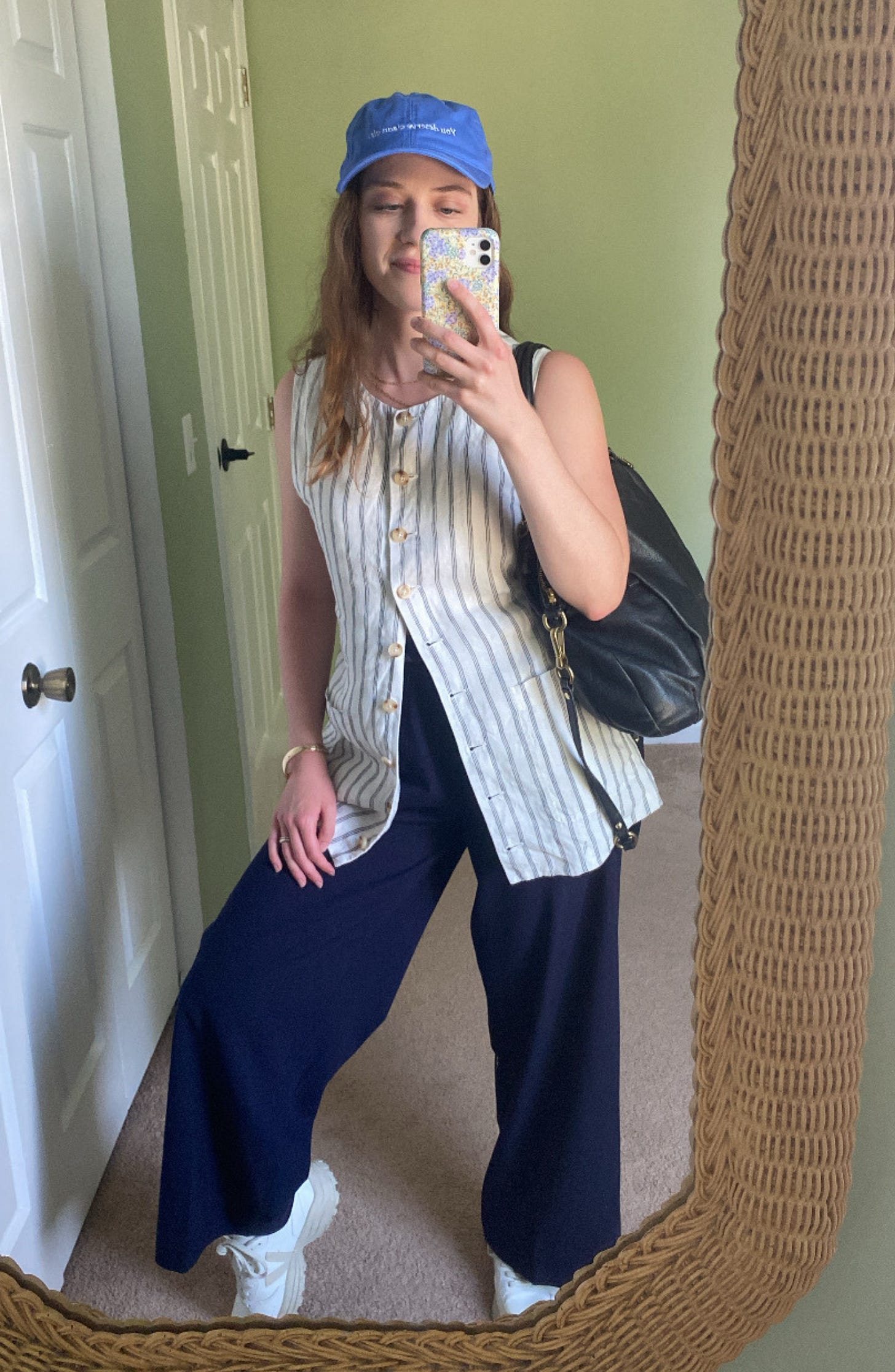
- I picked a foundational piece: My navy wide-leg trousers were business casual without being too formal and were practical for train travel.
- And functional accessories:My old Coach bag fits everything and my chunky Veja sneakers matched the vibe I was going for so those were the picks.
- Then a piece that brought it all together:At this point I was mixing high-contrast colors (white with navy & black) and different vibes (trousers vs. sneakers). I felt like I needed a bridge for the outfit, and this navy-striped vest tied it all together.
- Finally, some final touches: Gold jewelry made the look feel more “me”, while this cap from Abbie at The Filtery made it all feel effortless.
In the end, this outfit took a lot longer to create than a typical look.
It took longer to create than my usual outfits, but it felt just right. The combination was practical, suited my style, fit the vibe of the panel, and aligned with the weather.

This panel outfit reminded me that style is what we wear to express ourselves, but it’s also a tool to help us navigate our lives. By thinking through these layers of personal style (vibe, shapes, colors, textures, and lifestyle needs) we can balance showing up authentically while honoring the nuances or navigating the constraints of a situation.
For me, that’s the real power of personal style.
One single outfit can’t tell the whole story of who we are. But personal style can be flexible, functional, and expressive of the many sides of our multi-dimensional nature.
So lately, more than asking “does this outfit perfectly express my full self?” I’ve been finding myself asking:
“Does this outfit help me show up in the way I want to? Does it say what I want it to say in this particular moment?“
The post You’re multi-dimensional. So is your style. appeared first on .
Green Living
What Is a Third Place and Why Do They Matter?
Last Updated on October 2, 2025
It’s no secret my greatest love is theatre. From the time I was three years old, I knew I wanted to be an actor.
In an effort to make new friends after moving to Maine, I auditioned for a local production of Shrek. (One of my least favorite shows, but full of some of my soon-to-be favorite people). And you know what it taught me? Third places (theatre being one of them) matter.

Thanks to theatre, I fell into a gorgeous community, and these days, I volunteer in (almost) every corner (painting sets, assisting with costumes, and of course performing!). Here’s everything you need to know about what a third place is and why we need more of them.
what is a third place?
A third place is a public spot you can meet and connect with others through a shared interest or skill (like theatres!).
Third places are fantastic for socializing, exchanging ideas, and building community. Basically, a safe space to be yourself and find like-minded people.
Many third places are also entirely free, or low-cost. This is incredibly important because almost everywhere you go nowadays requires payment just to get in or participate. This creates an air of exclusivity and can keep lower income communities away.
But several third place areas are entirely free (like libraries and parks), or accessible due to their affordable pricing.
And beyond being good for our wallets, third places are equally good for our health. That’s because humans are social creatures that enjoy being around other people.
At third places like cafes, you can interact with strangers from various backgrounds and incomes in a positive, safe environment. Because everyone, from all walks of life, are welcome there.

why are third places disappearing?
Third places aren’t necessarily disappearing, but they were impacted by the pandemic when being around groups of people became hazardous.
Specifically, third places like coffee shops, bars, and gyms were hit hardest. However, the opposite was true for parks – everyone became aware just how important our outdoor spaces are.
That said, many third places never fully recovered from the pandemic when certain businesses realized they could function 100% remote. For example, if no one is arriving in person to a business office, a nearby cafe might suffer from less foot traffic. And rising rents don’t help matters.
Last but not least, certain people may find it difficult to locate a third place near them if they live in a rural setting. Third places tend to be easier to locate in cities.
However, third places can also be found through online communities (more on that later). The irony is the internet has also led to the decline of physical third places.
I think it’s important to have both so there’s a balance. Online communities are amazing, but there’s something about meeting people in person that hits different.

how is a third place different from a hangout?
A third place is different from a hangout in the sense you go there to socialize without any specific goal in mind. Or sometimes, you don’t socialize at all – but simply want to be around other like-minded people.
Whereas a hangout is more planned, a third places doesn’t demand any kind of itinerary or interaction if you don’t want to. Sometimes just hearing neighboring gossip or interacting with a barista is enough.
For example, if you go to a gym, you could chat up the person using the machine next to you. Or, you could simply enjoy the presence of others. There’s no right or wrong.
But with a hangout, you go with the intention of socializing and getting to know someone (or multiple someones).
how is a third place different from a club?
A third place is different from a club in the sense that clubs tend to be more exclusive, whereas third places are for everyone.
Typically, third places don’t have memberships (unless they’re gyms). There’s no barrier between you and that place. Everyone is welcome.
For example, if you’re trying to get into a ‘Homeowners Club’ the one requirement would be to be a homeowner. Which many Americans cannot afford, especially considering the cost of living is going up.
There’s no obligation to be at a third place. Nor are there any specific dress codes or strict requirements. Anyone from any class, culture and gender can participate without pulling rank.

why do third places matter?
Third places matter because they offer people another place to relax, unwind, and connect outside of their homes. Without spending aberrant amounts of money.
Third places encourage social connection without any pressure to perform. We choose how much we engage, if at all. And sometimes just being around other people is enough.
During the pandemic when only essential personnel were leaving the house, it was a stark reminder of how important these spaces are. Without human connection, mental health suffers.
On top of this, third places can be wonderful, neutral areas to do work and start projects. Think of your local cafe, bursting with people doodling in sketchbooks, writing in notepads and typing on laptops.
People flock to these locations not just for free WiFi – but to experience a change of scenery. Make light hearted conversation. Savor a cup of coffee made by someone else. Whatever the reason, there’s a clear need for them.
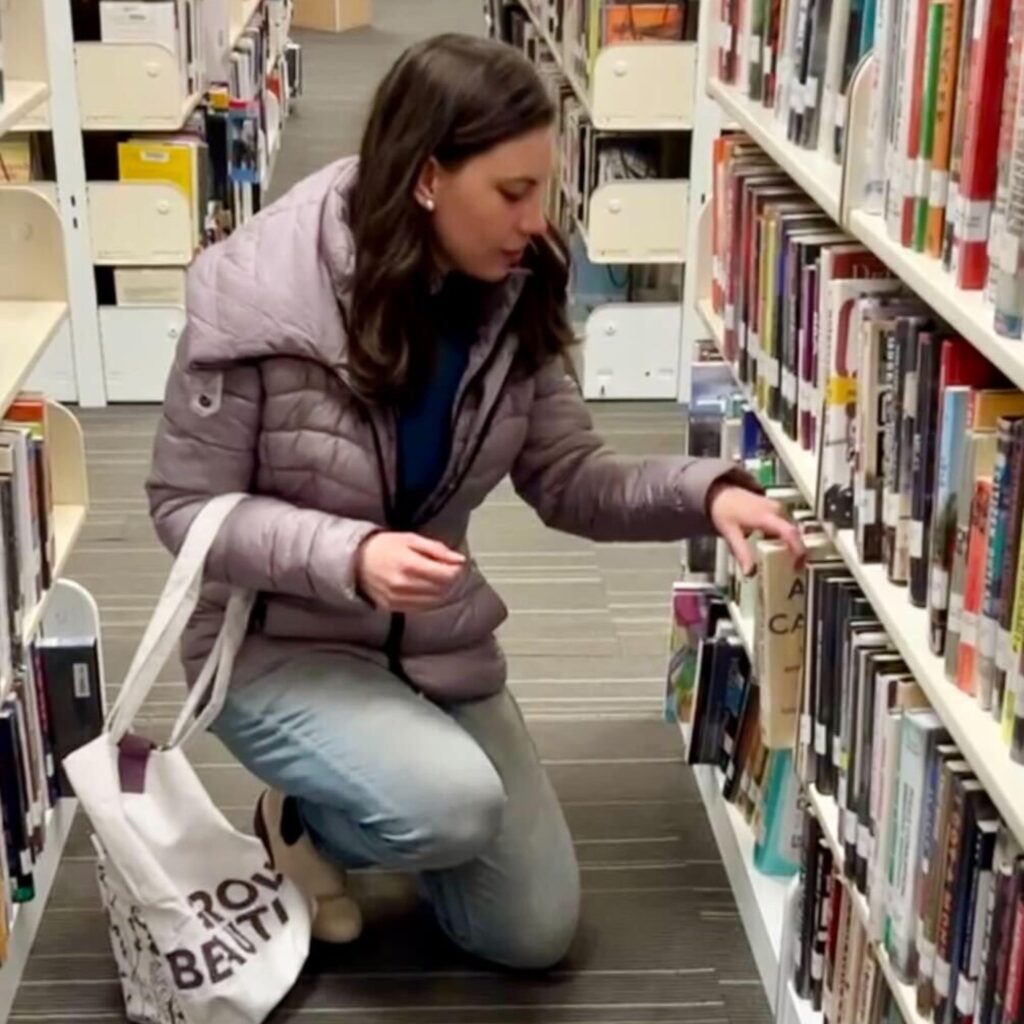
what are examples of third places?
There are several examples of third places, including:
- Libraries
- Parks, playgrounds and dog parks
- Cafes
- Theatres
- Bars and lounges
- State parks and nature reserves
- Gyms and yoga studios
- Recreation or community centers
- Community beautification group
- Community gardens
- Privately owned public spaces (like a plaza)
These are just a few I could think of off the top of my head, but I’m sure there are plenty more third places.
Also, be mindful of online third places as well! For those who don’t have access to any of the above, you may be able to find solace with online communities like Reddit groups, digital book clubs, Instagram group chats, and WhatsApp community groups.
That being said, there’s a charm to visiting a third place in person. So if you’re able, and have access to one, definitely take full advantage!
So, will you be visiting a third place? Let me know in the comments!
The post What Is a Third Place and Why Do They Matter? appeared first on Going Zero Waste.
-
Climate Change2 years ago
Spanish-language misinformation on renewable energy spreads online, report shows
-
Climate Change2 months ago
Guest post: Why China is still building new coal – and when it might stop
-
Climate Change Videos2 years ago
The toxic gas flares fuelling Nigeria’s climate change – BBC News
-

 Greenhouse Gases1 year ago
Greenhouse Gases1 year ago嘉宾来稿:满足中国增长的用电需求 光伏加储能“比新建煤电更实惠”
-
Greenhouse Gases2 months ago
Guest post: Why China is still building new coal – and when it might stop
-

 Climate Change1 year ago
Climate Change1 year ago嘉宾来稿:满足中国增长的用电需求 光伏加储能“比新建煤电更实惠”
-

 Carbon Footprint2 years ago
Carbon Footprint2 years agoUS SEC’s Climate Disclosure Rules Spur Renewed Interest in Carbon Credits
-
Renewable Energy3 months ago
US Grid Strain, Possible Allete Sale

